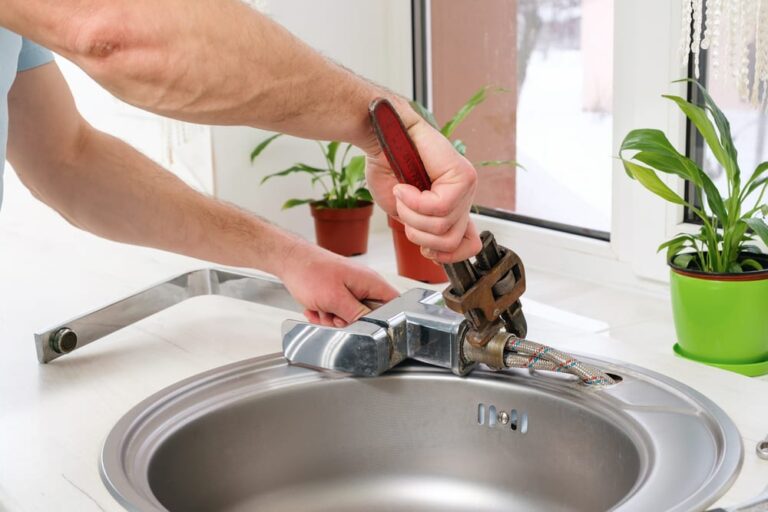Ask any homeowner about their biggest headaches, and plumbing problems often top the list.
I’ve spent over 20 years fixing pipes, unclogging drains, and stopping those annoying leaks that keep you up at night.
Many common plumbing issues don’t need a professional’s touch. You can handle them yourself with basic tools and a little know-how.
According to a recent survey by the American Housing Survey, about 10% of homes deal with plumbing problems every year.
That’s millions of drips, clogs, and running toilets! But before you grab your phone to search for a plumbing service near you, try these DIY fixes.
They’ll save you money and give you that awesome feeling of fixing something with your own hands.
Let’s roll up our sleeves and get those pipes and fixtures working properly again!
10 Simple Plumbing Fixes For A Well Maintained Home
Your home’s plumbing system works hard every day. Taking care of small issues before they grow into big problems keeps everything running smoothly. Here are ten common plumbing problems you can tackle yourself.
Leaky Faucets
That constant drip-drip-drip isn’t just annoying, it wastes water! A faucet leaking one drop per second wastes about 3,000 gallons per year. That’s like flushing money down the drain.
To fix a leaky faucet:
- Turn off the water supply under the sink first. Always!
- Cover the drain to prevent small parts from falling in.
- Take apart the faucet carefully, noting how parts fit together.
- Look for worn-out washers, O-rings, or cartridges—these are usually the culprits.
- Replace the bad parts with new ones from your local hardware store.
- Put everything back together in reverse order.
The key here is paying attention to how things come apart. I once had a customer who put their faucet back together three different wrong ways before getting it right! Take pictures with your phone if you need to.
Clogged Drains
Nothing ruins your morning faster than brushing your teeth over a sink that won’t drain. Before you pour harsh chemicals down there, try these gentler methods:
- Start with boiling water. Pour it slowly down the drain to melt soap scum and grease.
- If that doesn’t work, grab your plunger. Yes, sinks need plunging too!
- Still clogged? Try the baking soda and vinegar trick. Pour half a cup of baking soda down the drain, followed by half a cup of vinegar. Cover the drain, wait 30 minutes, then flush with hot water.
- For bathroom sinks, check the P-trap (that curved pipe under the sink). Put a bucket underneath, unscrew it, and clean out all the gunk.
For shower drains, hair is usually the problem. A simple drain snake or even a bent wire hanger can pull out that clog. It’s gross but satisfying!
Running Toilets
A running toilet can waste up to 200 gallons of water daily! That’s like flushing your hard-earned cash.
To fix a running toilet:
- Take off the tank lid and set it safely aside.
- Check if the water level is too high and going into the overflow tube. If so, adjust the float cup or ball.
- Look at the flapper. Is it sealing properly? If it’s warped or worn, replace it.
- Check the chain between the flush handle and flapper. It should have just a little slack.
- If the flush valve seat has mineral buildup, clean it gently with fine sandpaper.
Most toilet repair kits cost under $20 at hardware stores. I fixed my neighbor’s toilet last month, and she couldn’t believe how quick and easy it was. She’d been listening to it run for weeks!
Low Water Pressure
Stepping into a shower with weak water pressure starts your day on the wrong foot. Here’s how to fix it:
- Check if the problem affects all faucets or just one. If it’s just one, the issue is local.
- Look for leaks in your system. Even small leaks can reduce pressure.
- Clean your faucet aerators—unscrew the tip of the faucet and remove any gunk.
- For showerheads, soak them in vinegar overnight to dissolve mineral buildup.
- Check your pressure regulator (usually near your water meter). It might need adjustment.
A friend of mine complained about his shower pressure for years. Turns out, the previous homeowner had installed a water-saving showerhead. Replacing it solved the problem instantly!
Dripping Showerheads
Like leaky faucets, dripping showerheads waste water and can stain your tub or shower.
The fix is usually simple:
- Check the showerhead connection to the pipe. Often, it just needs tightening with a wrench. Use a cloth between the wrench and fixture to avoid scratches.
- If tightening doesn’t work, apply new plumber’s tape. Remove the showerhead, clean off old tape, wrap new tape clockwise around the threads, and reattach.
- If it still drips, the problem might be in the shower valve. Turn off the water supply, remove the handle, and check the cartridge for damage.
Replacing a shower cartridge sounds scary but isn’t much harder than changing a light bulb once you know what you’re doing.
Jammed Garbage Disposal
A stuck garbage disposal can put your kitchen out of commission. Before calling for help:
- Never, ever reach into the disposal with your hand!
- Turn off power to the disposal at the breaker box.
- Look underneath for a small hex-shaped hole. Insert an Allen wrench and turn it back and forth to free the jam.
- Some disposals come with a special tool for this job. Check your cabinets!
- Once unjammed, press the reset button on the bottom of the unit.
- Restore power and test.
To prevent future jams, always run cold water when using the disposal and avoid putting in fibrous foods like celery or potato peels. And remember—no bones, no grease, no egg shells!
Slow-Flushing Toilet
A toilet that flushes weakly might have hidden problems:
- Check the water level in the tank. It should be about an inch below the overflow tube. Adjust the float if needed.
- Look for clogs in the rim jets (the small holes under the toilet rim). Clean them with a toothpick or wire.
- Pour a bucket of water into the bowl. If it flushes well, the tank might not be filling properly.
- Check the flapper. If it closes too quickly, the flush won’t get enough water.
- For older toilets, check for mineral buildup in the siphon jet at the bottom of the bowl. You can clean it with a mirror and a coat hanger.
I once had a customer who swore her toilet was possessed because it flushed differently every time. Turned out she had kids who liked to flush their small toys!
Leaky Pipe Joints
Water stains on ceilings or cabinets often signal leaky pipe joints. Catching these early prevents major damage:
- Turn off the water supply first.
- Dry the pipe completely.
- For compression fittings, try tightening the nut slightly with a wrench.
- For threaded joints, remove old plumber’s tape and apply new tape.
- For small leaks, pipe repair clamps offer a quick fix until you can replace the section.
One customer ignored a small leak under his sink for months. By the time he called me, the cabinet floor had rotted completely! A five-minute fix turned into a two-day cabinet repair job.
Noisy Pipes (Water Hammer)
That banging sound when you turn off a faucet isn’t your house falling apart—it’s water hammer.
To quiet noisy pipes:
- Drain your plumbing system completely. Turn off the main water valve, open all faucets, and flush toilets.
- Turn the water back on and close all faucets. This should refill the air chambers that cushion water flow.
- If that doesn’t work, install water hammer arrestors near problem fixtures.
- Secure any loose pipes under sinks or in crawl spaces with pipe straps.
My own pipes used to sound like someone hitting them with a hammer every time I turned off the kitchen sink. Five minutes of work solved a problem that had annoyed me for years!
Smelly Drains
Nobody wants a stinky sink or shower drain. Those odors usually come from bacteria feeding on trapped gunk:
- Pour boiling water down the drain to flush away light buildup.
- For stronger cleaning, pour a cup of baking soda down the drain, followed by a cup of vinegar. Let it bubble for 30 minutes, then rinse with hot water.
- Clean the P-trap under sinks. Put a bucket underneath, unscrew the trap, and clean out all debris.
- Check for proper venting. Sewer gases should exit through roof vents, not your drains.
- If the smell persists, your drain might need snaking to remove deeper clogs.
A bathroom drain in my house smelled terrible until I pulled out what looked like a small furry animal, actually just a massive hairball mixed with soap scum. Gross but fixable!
Conclusion
Taking care of these common plumbing problems yourself can save hundreds of dollars and give you real satisfaction. Most fixes need just basic tools: adjustable wrench, pliers, plunger, and screwdriver.
Of course, know your limits. If you’ve tried these solutions without success, or if you have older pipes that might break easily, it’s time to call a pro. Water damage can cost thousands to repair, so don’t risk it if you’re unsure.
Keep this guide handy, and you’ll be ready next time a plumbing problem pops up. Your wallet will thank you, and you’ll have some great stories to tell about that time you conquered your home’s plumbing all by yourself!



